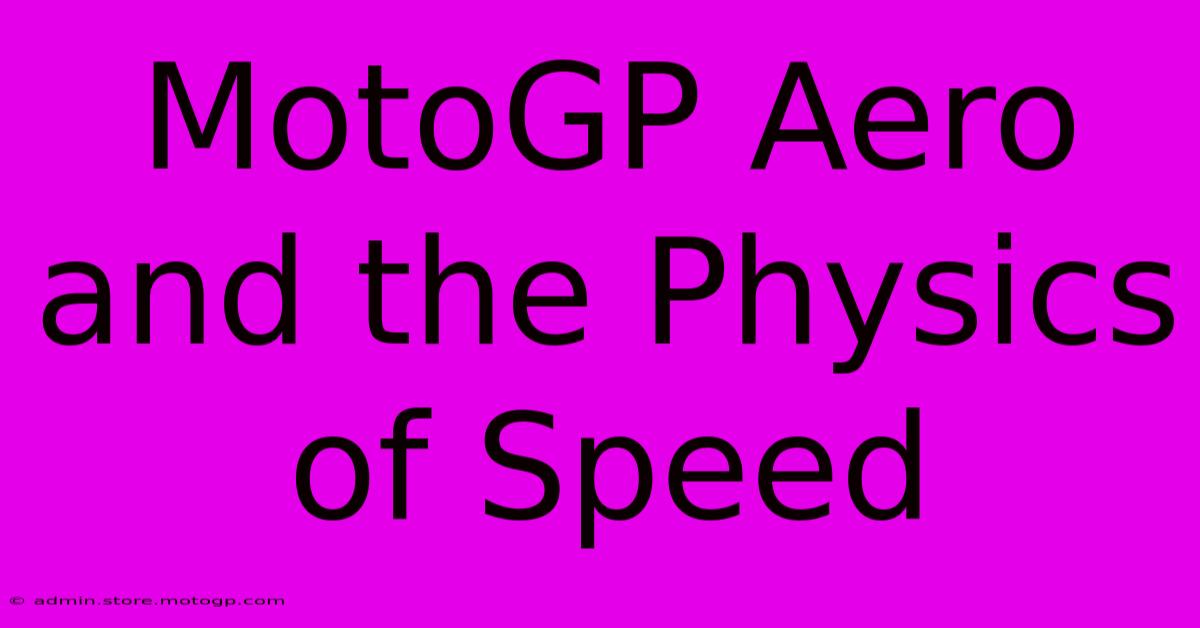MotoGP Aero And The Physics Of Speed

Table of Contents
MotoGP Aero and the Physics of Speed: A Deep Dive into Downforce and Drag
MotoGP, the pinnacle of motorcycle racing, is a relentless pursuit of speed. But raw horsepower isn't the only factor determining victory. Sophisticated aerodynamics, often simply referred to as "aero," play a crucial role, influencing stability, cornering speeds, and ultimately, lap times. This article delves into the physics behind MotoGP aero, exploring how downforce and drag impact rider performance.
Understanding Downforce and Drag
Before diving into the specifics of MotoGP aero, let's establish the fundamental forces at play:
Downforce: This is the force pushing the motorcycle downwards, essentially "gluing" it to the track. It's generated by aerodynamic components designed to channel airflow, creating a pressure difference between the top and bottom surfaces. More downforce means greater grip, allowing for faster cornering speeds and more aggressive braking.
Drag: This is the force resisting the motorcycle's forward motion. It's primarily caused by air resistance acting against the motorcycle's surface area and shape. Minimizing drag is essential for maximizing top speed on straights.
The challenge for MotoGP engineers is striking a delicate balance between these two forces. Too much downforce might impede top speed, while insufficient downforce compromises cornering stability.
The Role of Aerodynamic Components
Modern MotoGP bikes are festooned with aerodynamic appendages, each meticulously designed to influence downforce and drag:
-
Wings: These are perhaps the most visible aerodynamic components. Their design – including the angle of attack, shape, and size – directly impacts downforce generation. Different wing configurations are used depending on the track characteristics.
-
Fairings: The sculpted bodywork around the rider and engine is designed to minimize drag and manage airflow efficiently, directing it to create downforce at strategic points.
-
Winglets: Smaller wings, often integrated into the fairing, are employed to fine-tune airflow management and further enhance downforce.
-
Underbody Aerodynamics: The design of the underbody is crucial for generating downforce. By carefully shaping the airflow underneath the bike, engineers create a low-pressure zone, further increasing the downward force.
-
Airducts: These channel air to various parts of the bike, cooling the engine and brakes, while sometimes also contributing to aerodynamic efficiency.
The Physics Behind the Performance
The principles governing MotoGP aerodynamics are grounded in fluid dynamics:
-
Bernoulli's Principle: This principle states that faster-moving air exerts lower pressure. Wings, for instance, are shaped to accelerate airflow over their upper surface, creating a lower pressure zone and generating a lift-like force downwards (downforce).
-
Newton's Third Law: For every action, there's an equal and opposite reaction. The downforce generated by the aerodynamic components pushes the bike down, while the track exerts an equal and opposite upward force, providing superior grip.
-
Angle of Attack: This is the angle between the aerodynamic surface (e.g., a wing) and the oncoming airflow. Adjusting the angle of attack changes the amount of downforce generated; a steeper angle creates more downforce, but at the cost of increased drag.
The Ever-Evolving Landscape of MotoGP Aero
MotoGP aerodynamics is a constantly evolving field. Teams invest heavily in Computational Fluid Dynamics (CFD) simulations and wind tunnel testing to refine designs and optimize performance. Regulations often change, pushing teams to innovate and find new ways to gain an advantage. The pursuit of aerodynamic perfection is an ongoing race, as critical to success as engine power and rider skill.
Conclusion: A Symphony of Speed and Science
The quest for speed in MotoGP isn't just about horsepower; it's a sophisticated interplay between engineering prowess and the fundamental principles of physics. Understanding the complex relationship between downforce, drag, and aerodynamic components is crucial to appreciating the technological marvel that is a modern MotoGP machine. The constant evolution of aero technology ensures that the battles on the track will continue to be as fascinating as ever, a thrilling combination of raw power and aerodynamic finesse.

Thank you for visiting our website wich cover about MotoGP Aero And The Physics Of Speed. We hope the information provided has been useful to you. Feel free to contact us if you have any questions or need further assistance. See you next time and dont miss to bookmark.
Featured Posts
-
Moto Gp Tracks A World Of Excitement
Feb 21, 2025
-
Witness The Champions Sprint Race Austin
Feb 21, 2025
-
Racing Style Essentials Find Them At The Cota Gift Shop
Feb 21, 2025
-
Moto2 Specifications Engineering Marvels Revealed
Feb 21, 2025
-
Moto Gp A Celebration Of Speed Tnt Sports
Feb 21, 2025
